#Guanshiyin
Explore tagged Tumblr posts
Text

On the 19th day of the 2nd lunar month, we honor the sacred birthday of the Greatly Compassionate and Merciful Guanyin Bodhisattva 🙏🏻. It is a blessed day to sincerely worship, recite scriptures, practice vegetarianism, release life, offer lamps, chant mantras, and pray for world peace, harmony, and prosperity. ✨ May your heart be at peace, your path be smooth, your family be harmonious, and your wealth flourish. 🌷
🔮 Discover your #destiny with a personalized #ziweidoushu reading today!
https://ngocnga.net/zi-wei-dou-shu/?utm_source=tumblr&utm_medium=social&utm_campaign=ziwei
#Guanyin#Guanshiyin#Avalokitesvara#GuanyinBodhisattva#GoddessofMercy#Buddhism#destiny#ziweidoushu#zwds#purplestar#purplestarastrology#chineseastrology#astrology#metaphysics#chinesemetaphysics
2 notes
·
View notes
Text
Rise's Persona is really fitting
Alright, I’m going to admit, I don’t know much about Buddhism since I didn’t really grow up learning about it. My family isn’t Buddhist in even a cultural sense. So any real Buddhists who also love Rise, please fact check me here. This analysis is not going to be as deep as I’d like…
So, Rise’s awakened Persona is Kanzeon. Which is the Japanese name of Guanshiyin, “[one who] perceives the world’s sounds.” Guanshiyin is the Chinese name of Avalokiteśvara, the bodhisattva of compassion. Their whole role (Avalokiteśvara is usually portrayed as a guy but in the Sinosphere they’re a girl.) is that they’re refraining from attaining Buddhahood until everyone reaches enlightenment.
I just think them being her awakened Persona really fits her on so many levels—as a Navigator and as a person.
When Naoto and Rise chat in Junes on October 13, Naoto actually explains to Rise exactly why Rise being the navigator makes more sense over Naoto.
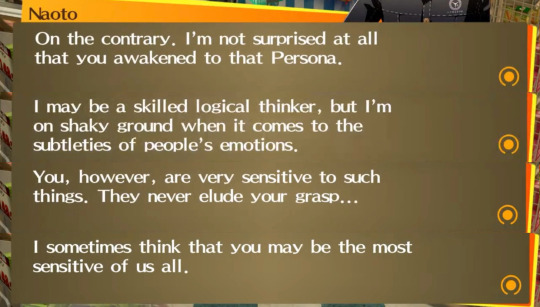
And Naoto is a lot of things, and correct is one of them. Rise is highly perceptive when it comes to other people’s emotions and feelings, which is incredibly useful when you’re in the TV world, which is the embodiment of thought—which is driven by emotion, as shown by Teddie's comments in Yukiko's castle, and Rise realizing why your items disappear in Marie's Hollow Forest.

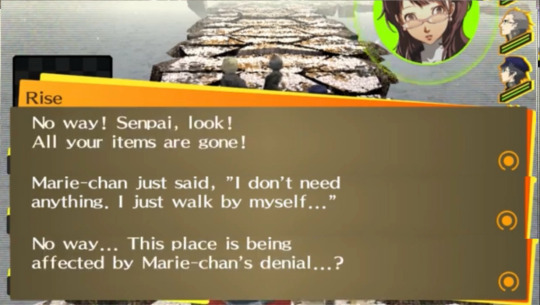
She's also insanely compassionate. Rise actually is driven to continue her work as an idol by not just her genuine love of acting and singing, but her own compassion for others. In her Social Link’s epilogue she talks about the little girl that wrote her letters that she mentioned in her Social Link and how much she cares for that girl.
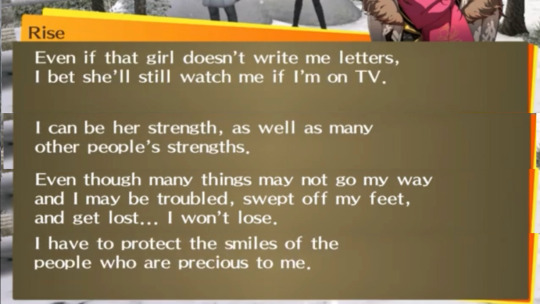
(I think a lot about these lines… fits with the whole thing of Avalokiteśvara being determined to bring everyone to enlightenment, being a guide to help people bring out their strengths (and also getting rid of the desire that weakens them, as from what I know, personal desire is seen as the cause of suffering in Buddhism). Also just the fact she cares so much for a girl she’s never met, having her be mentioned as part of those precious to her that she wants to protect the smile of is… really sweet.
With the whole thing of Rise being a Navigator. Kanzeon’s a pretty perfect fit for the reasons mentioned above, and gameplay-wise I think Rise’s the strongest Navigator since she has that “revive the protagonist” ability.
Also, Kanzeon’s face resembles a satellite—as Kouzeon, a telescope. Satellites are mainly used to gather information around the world, whether it's related to weather events like typhoons/hurricanes, whether it's related to the state of the ozone layer, or when it comes to telescopes, observing other worlds in the solar system. And a Navigator's main power is to analyze enemies to see what strengths and weaknesses they have.
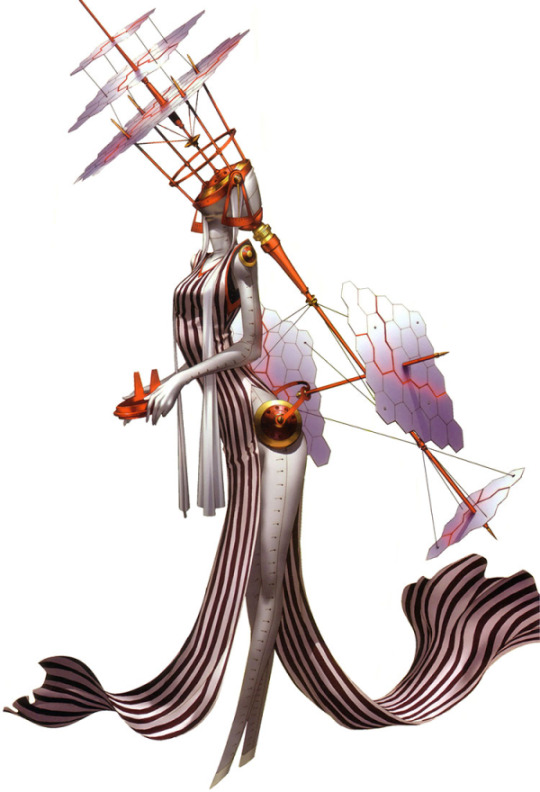
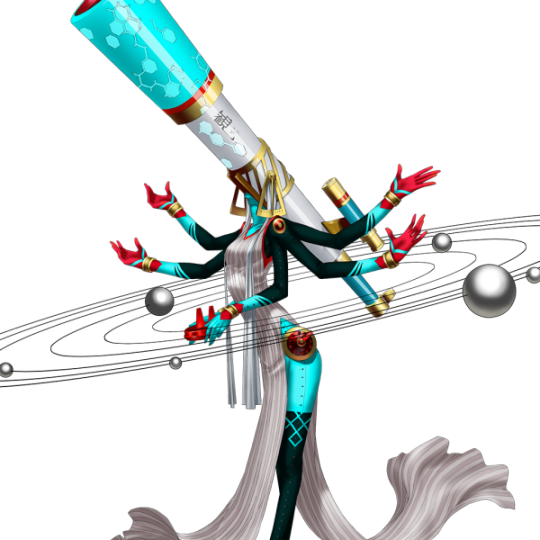
(Also if you’re wondering what the kanji on Kouzeon’s telescope is, it’s the “Kan” in Kanzeon. "To perceive". Also I'm pretty sure the telescope is a visual pun for that.) I’m pretty sure Kouzeon having multiple arms is a reference to the actual bodhisattva also having numerous arms—they’re sometimes named Thousand-Armed Avalokiteśvara!
#Rise Kujikawa#I should read Journey to the West it has Guanshiyin in it#and inspired many a Japanese story#I mean Dragon Ball’s main character is named after a major character: Sun Wukong!!#I’m a little surprised that I can talk this much about. Her persona#I can’t tell if that’s a testament to how much thought is put into Persona 4 or my passion or both#persona 4#persona 4 spoilers#persona 4 golden#This is more scattered than usual because my buddhism knowledge is. low#I’m so sorry#analyzing the fog
11 notes
·
View notes
Text
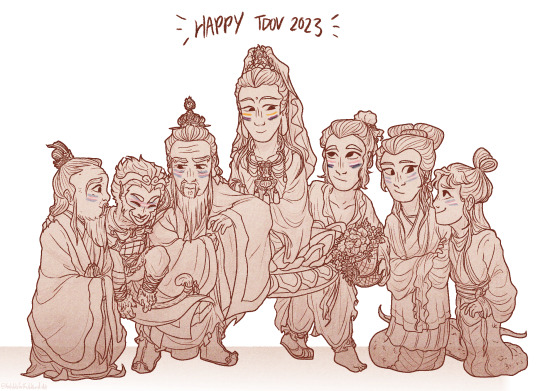
A little late but happy Trans Day of Visibility!!!
[ID: A monochrome chibi drawing of various figures from Chinese folklore with pride flags painted onto their faces. From left to right are Taibai Jinxing, Sun Wukong, Taishang Laojun, Guanshiyin Pusa, Lan Caihe, Bai Suzhen, and Qing She. Guanyin has nonbinary flags and Lan Caihe has genderfluid flags, but everyone else has trans flags. Above them is written "Happy TDOV 2023!" End ID]
#my art#tdov#tdov23#chinese mythology#journey to the west#jttw#xiyouji#sun wukong#monkey king#legend of the white snake#bai suzhen#qing she#xiao qing#wanna make it very clear that i am referring to folkloric deity taishang laojun not historical figure laozi. bc thatd be insane gfhdjkfdh#anyways no nezha this year bc i decided to go with only historic and/or reasonably textually supported characters ^-^#will add details in a reblog
491 notes
·
View notes
Text

"One who looks with unwavering eye" Avalokiteśvara Talon Abraxas
In Buddhism, Avalokiteshvara, or Chenrezig, is known as the bodhisattva of compassion. A bodhisattva is a being who has completed their journey towards enlightenment, but postpones entering nirvana in order to help others along their path to enlightenment first.
Bodhisattva Avalokiteshvara is a deity with many forms and names depending on which of the various regions and cultures across Asia he is mentioned in. In Chinese Buddhism, he is synonymous with the goddess Kuan Yin (also known as Guan Yin, Quan Yin, or Guanshiyin), his female form. Bodhisattvas are considered genderless therefore allowing them to manifest into a multitude of forms, as well as bare female and/ or male characteristics freely. One of Avalokiteshvara’s most iconic artistic depictions is that of thousand armed Avalokiteshvara; with one thousand arms and/ or eyes surrounding him like a fan, he is ready and able to see and help all those in need. He is also commonly portrayed as adorned with opulent robes and jewels to attest to his grand status as a deity, and to convey his presence in the material realm. “Om Mani Padme Hum”
23 notes
·
View notes
Text
“You were reckless.”
“I did what I had to do.”
“Spare me the good marine bullshit.”
Bobbie knew her actions back on the Guanshiyin might have been a little daring, but calling it reckless was a bit of a stretch. She knew Chrisjen well enough by now to recognize that this was just an excuse for her to verbalize her anger.
19 notes
·
View notes
Text

Hello fellow pilgrims! I hope that you all had a nice rest and are raring to go through the next major part of this literary journey. And lucky for us we begin with the conclusion of the first volume's cliffhanger, following everyone's favorite superpowered monkey as he looks through heaven and earth for a way to restore the ginseng tree he uprooted.
Also keep in mind that while today is dedicated to Chapter 26: "Amid the Three Islands Sun Wukong seeks a cure; With sweet dew Guanshiyin revives a tree," it is this club's policy to accept your creative creations concerning this classic for every chapter that we've already covered.
So a big welcome in to those who are just joining us, and a big welcome back to those who've been here since Volume 1! I'm very excited to see what each of you gain from this adventure.
37 notes
·
View notes
Text

The age-old question, will this drawing get deleted? x'D
Anyway, here is another sneak peek. -w-
The uncensored version. 👀
#bobbie x chrisjen#bobbie draper#chrisjen avasarala#chrisjen x bobbie#the expanse#sneak peek#my art#fanart
63 notes
·
View notes
Text
Westward Journey Online II (2002) 大话西游2经典版


Date: August 15, 2001 / August 07, 2015 Uncoded test Platform: PC Developer: NetEase Publisher: NetEase Genre: Turn-Based Theme: Fantasy Franchises: Westward Journey Online Aliases: New Westward Journey 2 / Westward Journey 2 Classic Edition / Westward Journey Online / Westward Journey Online III Type: Reimanging
Summary:
Since Pangu opened up the world, the heavens are divided into three realms, and the earth is divided into four continents. All ethnic groups coexist in Dongsheng Shenzhou, Xiniu Hezhou, Nanzhanbuzhou, and Beijuluzhou, thus determining the pattern of heaven and earth. All species originally coexisted peacefully: The immortal clan ruled and dominated everything from above, the human race admired the brilliance of the gods and reproduced endlessly, the demon clan was always sealed in the darkness and lived stubbornly but arrogantly, the ghost clan continued the cycle of yin and yang, and lived freely in the underworld... all things in the cycle of reincarnated endlessly, and tens of thousands of years of time flow like water.
However, an accident 13,000 years ago caused the Demon Race to invade the Immortal Race, disrupting the order of the entire world, and the Ghost Race gradually became stronger. According to the historical records of the Heavenly Court: On the day when the demons slaughtered the immortals, the sky and the earth changed color, the sun and the moon were dimmed, the terrain of the invasion was like a broken bamboo, and the guards of the Heavenly Court were like fallen leaves in a strong wind... It can be seen that the degree of tragedy is extraordinary. After this battle, the dominance of the fairy clan was also shaken, and the sealed demon clan began to wait for an opportunity to come out. Wrathful ghosts and wild ghosts were everywhere in the land of Shenzhou, monsters are reborn, and it is even more difficult for mortals to resist the demons in their hearts as hate and killing fill the world. In the human world and the underworld, ghosts gathered for a while, and the ghost clan gradually awakened in the chaos of war and came to the Three Realms.
In a blink of an eye, it was the Tang Dynasty. It is said that one day, the Tathagata Buddha summoned all the Buddhas, Arrows, Jiedi, Bodhisattvas, arhats, monks, and nuns in the Daleiyin Temple of Lingshan to give lectures on the Dharma. He talked about the great numbers of the world and the good and evil of all living beings. Immediately, his compassion arose, so he summoned Guanshiyin Bodhisattva from the South China Sea, saying that there is a Tripitaka of Mahayana Buddhism, which can transcend the souls of the dead, free them from suffering, and make life and body invincible. However, those who have a predestined relationship with Buddha need to pray sincerely and overcome ninety-nine and eighty-one difficulties. Only by getting rid of the shackles of the physical body can he retrieve it; then he uses this scripture to pass on to the Eastern Tang Dynasty, and it can relieve the calamity between heaven and earth. So Guanyin enlightened the Buddhist monks to go west to learn Buddhist scriptures. Helplessly, the world has been determined, and the path to learn from the scriptures is doomed to be full of hardships.
At this time when the world is full of numbers, when immortals, humans, demons, and ghosts coexist in the world, you were born in a fishing village on the shore of the East China Sea that gathers the essence of heaven and earth, the aura of mountains and rivers, and talented people come forth in large numbers. People in the village say those who are born here are the people of destiny who shoulder the important task of resolving the great numbers in the world. So, you are on your way.
Source: https://baike.baidu.com/item/%E5%A4%A7%E8%AF%9D%E8%A5%BF%E6%B8%B82%E7%BB%8F%E5%85%B8%E7%89%88?fromModule=lemma_search-box
Link: https://www.youtube.com/watch?v=FNeQlXej8YE&ab_channel=thitramy https://www.bilibili.com/video/BV1aN4y177F5/ https://xy2.163.com/
#Westward Journey Online II#大话西游2经典版#大话西游2#NetEase#jttw media#jttw game#game#video game#reimagining#continuation#sun wukong#six eared macaque
46 notes
·
View notes
Text
Chapter 26 is out! Welcome to Volume 2 :)
10 notes
·
View notes
Text


Not sure but I think this might be Guanyin/Avalokiteśvara/Kannon on this screen in "Zashiki Warashi." Definitely a bodhisattva anyway.
Guanyin (traditional Chinese: 觀音; simplified Chinese: 观音; pinyin: Guānyīn) is a Bodhisattva associated with compassion. She is the East Asian representation of Avalokiteśvara (Sanskrit: अवलोकितेश्वर) and has been adopted by other Eastern religions, including Chinese folk religion. She was first given the appellation "Goddess of Mercy" or "Mercy Goddess" by Jesuit missionaries in China. Guanyin is short for Guanshiyin, which means "[The One Who] Perceives the Sounds of the World." [from Wikipedia]
#mononoke 2007#mononoke screencaps#zashiki warashi#this is the first time I've watched ZW immediately after A:Bakeneko and it's a trip
15 notes
·
View notes
Text
nobody got to vote before I decided how I should build this wretched thing
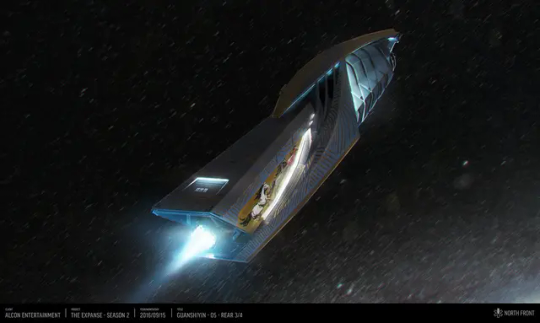
we don't have enough high-end civvie DropShip designs, so why shouldn't I build the Guanshiyin as a new class (probably a bespoke one built in part to obfuscate the budget for the Amun-Ra, much like a lot of Batman's stuff)
3 notes
·
View notes
Text
🙏🌟🌸 On the nineteenth day of the second lunar month is the birthday of #GuanyinBodhisattva. When encountering Bodhisattva, do not ignore it. May the light of Buddha shine upon you, may all things be auspicious and complete.
🔮 Zi Wei Dou Shu (紫微斗数), also known as Purple Star Astrology, is a traditional form of Chinese astrology that is based on the position of stars at the time of a person's birth. Learn more at https://ngocnga.net/read-your-chinese-astrology-zi-wei-dou-shu/?utm_source=tumblr&utm_medium=social&utm_campaign=ziwei
#ziweidoushu#zwds#purplestar#purplestarastrology#chineseastrology#astrology#metaphysics#chinesemetaphysics#Guanyin#Guanshiyin#Avalokitesvara#GoddessofMercy#Buddhism
1 note
·
View note
Text
E. Cobham Brewer's 1894 Dictionary of Phrase & Fable contained the entry, "Hecate: A triple deity, called Phoebe or the Moon in heaven, Diana on the earth, and Hecate or Proserpine in hell," and noted that "Chinese have the triple goddess Pussa"
any guesses on the identity of Pussa? the closest i can find is that guanyin is referred to as Guanshiyin Pusa but shes not traditionally triplicate. possibly a confusion from many names?
19 notes
·
View notes
Photo

Guanyin is short for Guanshiyin, which means "[The One Who] Perceives the Sounds of the World." #kannon #guanyin #avalokitesvara https://www.instagram.com/p/CqoKEMgPO0f/?igshid=NGJjMDIxMWI=
8 notes
·
View notes
Text

Avalokiteśvara Talon Abraxas
In Buddhism, Avalokiteshvara, or Chenrezig, is known as the bodhisattva of compassion. A bodhisattva is a being who has completed their journey towards enlightenment, but postpones entering nirvana in order to help others along their path to enlightenment first.
Bodhisattva Avalokiteshvara is a deity with many forms and names depending on which of the various regions and cultures across Asia he is mentioned in. In Chinese Buddhism, he is synonymous with the goddess Kuan Yin (also known as Guan Yin, Quan Yin, or Guanshiyin), his female form. Bodhisattvas are considered genderless therefore allowing them to manifest into a multitude of forms, as well as bare female and/ or male characteristics freely. One of Avalokiteshvara’s most iconic artistic depictions is that of thousand armed Avalokiteshvara; with one thousand arms and/ or eyes surrounding him like a fan, he is ready and able to see and help all those in need. He is also commonly portrayed as adorned with opulent robes and jewels to attest to his grand status as a deity, and to convey his presence in the material realm.
49 notes
·
View notes
Text
Accounts of the temple of Ashoka (LS54)
[According to Buddhist legend, Ashoka, ruler of the Mauryan empire, built 84 000 stupas in honour of the Buddha. By Liang times, it was claimed that just such a stupa had been found in Kuaiji!
This should probably be viewed as part of a larger program to legitimize the Jiankang state and its ruler as an integral part of the larger Buddhist world.]
King Ashoka [ayu wang阿育王] is precisely the Iron Wheel King. He was king over Jambudvipa [the Indian subcontinent, Yanfuti閻浮提] and united Under Heaven. After the Buddha's nirvana, in one day and one night, he conscripted ghosts and spirits to construct 84 000 stupas, this was precisely one of them. In the time of Wu, there was Buddhist nun who lived on that land, she made a small monastery. Sun Chen soon after demolished and removed it. The stupa was also destroyed with it. After Wu was pacified, various people of the Way again erected it at its old place.
When Zhongzong of Jin [i.e. Emperor Yuan] began to cross the Jiang, he immediately adorned and decorated it. Arriving at Jianwen's Xian'an era [371 – 372], he sent the sramana Teacher An to go there and construct a small stupa. It was not yet complete when he perished. His disciple Monk Xian carried on, and adorned the construction. Arriving at Xiaowu's 9th Year of Taiyuan [384 AD], they put up gold on the wheels and the parasols.
After that, in Lishi county in Xihe there was a Hu person called Liu Sahe who became ill and suddenly perished, but below the heart he was still warm. His family had not yet dared to bury him right away when after ten days, he revived again. He told them:
There were two functionaries making recordings. [I] travelled toward the north-west, but did not measure if it was far or near, until [I] arrived in the Eighteen Hells. Subsequently there was retribution, heavy or light, and [we] received various painful abuses. [I] saw the Guanshiyin [Bodhisattva] who spoke: “Your destiny is not yet ended. If [you] manage to live, [you] can become a sramana. Below Luo, inQicheng, Danyang, and Kuaiji all have King Ashoka's stupas, you can go there and worship. If [your] natural lifespan ends, [you] will not fall into hell. Her speech finished, it was like [I]fell from a tall cliff, and suddenly [I] woke up from sleep.
Following that, he set out from his family, and took the name Huida. He roamed and travelled to pay respect at the stupas and in turn arrived in Danyang, but he did not know where the stupa was located. He therefore climbed the walls of Yue [?] and looked around. He saw a strange coloured aura a thousand li long. Following that, he went there to worship, and it really was where King Ashoka, which frequently let out a glowing light. With that, he certainly knew there was sure to be sarira [Buddhist relics], and therefore assembled a multitude to go there and dig for them. When they had gotten a zhang in, they obtained three stone steles, each six chi long. On the middle stele there was and iron box, inside the box there was a silver box, and inside that box there was a gold box. It was filled with three sarira and a nail and a hair, one of each. The hair was several chi long. They immediately moved the sarira closer north, to stand opposite west of the stupa Jianwen had built, and built single storey stupa. 16th Year [f Taiyuan?, 391 AD], they also sent the sramana Monk Shangqie to make it three storeys, which was precisely the one opened by Gaozu [of Liang].
…
Middle of Jin's Xianhe era [326 – 334], the Governor of Danyang, Gao Kui, travelled the to the Zhanghou Bridge, and saw on the bank a five coloured glove, several chi long. He did not know why, and therefore ordered people to the location of the glow to dig in the ground and look at it. He They obtained a golden statue, but it had not yet a glowing base. Kui therefore sent down a chariot, to transport the statue back. When they arrived at the head of the Changgan Lane, the ox was not willing to advance. Kui therefore ordered the driver to trust in what the ox was doing. The ox straight away pulled the chariot to a temple, and Kui following that kept the statue in the care of the temple monks. Always at midnight, it would constantly let out a glowing light, and also they heard within the hollow the sound of metal and stone.
One year had passed, when a fisherman, Zhang Xishi, at the mouth of the sea suddenly saw a copper flower base floating on the water. Xishi took it and sent it to the county, and the county sent it to the palace. They set it up as the foot of the statue, and it was as if they were joined together.
It happened that in Jianwen's 1st Year of Xian'an [371 AD], a native of Hepu in Jiao province, Dong Zongzhi, was collecting pearls submerged in water, and at the bottom obtained a Buddha bright and beautiful. Jiao province compelled him to send it to the palace. They set it up with the state and it also joined with it. From the middle of Xianhe until the beginning of Xian'an, more than thirty years had passed when the glowing base was first arranged.
Earlier, after Gao Kui had obtained the statue, a five Hu monks from the Western Regions came to Kui, and said:
Formerly [we] obtained in Tianzhu a statue made by King Ashoka. [When we] came down to Ye, [we] encountered the chaos of the Hu and buried the statue on the edge of the Yellow River. Now [we are] seeking and searching for what I have lost.
The five people once in a single night all dreamt that they saw the statue, which said:
[I] have already set out for Jiangdong, and been obtained by Gao Kui.
Kui therefore sent these five monks to the temple. When they saw the statue, they sighed, sobbed, and wept tearfully. The statue right then began to glow, the shine lit up the roof of the hall.
There also was Huisui of Waguan Temple who wished to make a copy shaped like the statue. The temple master Monk Shang worried it would damage or diminish the golden statue, and he spoke to Sui, saying:
If [you] are able to make the statue begin to glow, and turn its body westward, then [you] can have permission.
Huisui right then went to humbly request it. That night the statue promptly moved its position and began to glow, turning its body westward. Next morning he right then was allowed to copy it. The base of the statue previously had writings from a foreign state, and nobody could understand it. Later the Tripitaka Ran Fu sought out a Bamo跋摩[?] who understood it. He stated that this had been made by King Ashoka's fourth daughter.
0 notes